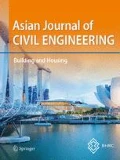Abstract
Building information modeling (BIM) is an intelligent 3D model-based process which is more efficient and effectively used by architecture, engineering and construction professionals for planning, designing, constructing and managing buildings in an efficient manner. This literature review in this paper illustrates the benefits of BIM adoption and the barriers to its implementation. About 131 professionals which include the architects and engineers of the architecture, engineering and construction (AEC) industry, are part of this study. AEC industry was chosen for completing the survey among which only 102 of them completed the survey, as the remaining were not even aware of BIM. The objective of the study is to know about the attitude of the professionals regarding the positive and negative factors influencing the implementation of BIM in the AEC industry. The paper concludes with the strategies for the implementation of BIM on a large scale.

Similar content being viewed by others
References
Araici, Y., Coates, P., Koskela, L., & Kagioglou, M. (2011). BIM adoption and implementation for architectural practices. Journal of Information Technology in Construction, 6(5), 401–411.
Azhar, S. (2011). Building information modeling (BIM): Trends, benefits, risks and challenges for the AEC industry. Leadership and Management in Engineering, 3(1), 194–203.
Barlish, K., & Sullivan, K. (2012). How to measure the benefits of BIM—A case study approach. Automation in Construction, 9(5), 149–159.
Becerik-Gerber, B., & Rice, S. (2010). The perceived value of building information modeling in the U.S. building industry. Journal of Information Technology in Construction, 15(4), 185–201.
Bernstein, G., & Pittman, H. (2004). Barriers to the adoption of building information modeling in the building industry. Automation in construction, 5(5), 500–505.
Bryde, D., Broquetas, M., & Volm, J. M. (2013). The project benefits of building information modeling (BIM). International Journal of Projec Management, 7(4), 971–980.
Chan, C. T. W. (2014). Barriers of implementing BIM in construction industry from the designers’ perspective: A Hong Kong experience. Journal of System and Management Sciences, 4(2), 75–86.
Czmoch, I., & Pekala, A. (2014). Traditional design versus BIM based design. Procedia Engineering, 6(2), 210–215.
Eadie, R., Odeyinka, H., Browne, M., McKeown, C., & Yohanis, M. (2013). An analysis of the drivers for adopting building information modeling. Journal of Information Technology in Construction, 5(4), 203–212.
Eadie, R., Odeyinka, H., Browne, M., McKeown, C., & Yohanis, M. (2014). Building information modeling adoption: An analysis of the barriers to implementation. Journal of Engineering and Architecture, 2(1), 77–101.
Fazli, A., Fathi, S., Enferadi, M. H., Fazli, M., & Fathi, B. (2014). Appraising effectiveness of building information management (BIM) in project management. Procedia Engineering, 7(7), 1116–1125.
Khaddaj, M., & Srour, I. (2016). Using BIM to retrofit existing buildings. International Conference on Sustainable Design, Engineering and Construction, 9, 1526–1533.
Kreider, R., Messner, J., & Dubler, C. (2010). Determining the frequency and impact of applying BIM for different purposes on Projects. Automation in Construction, 2(1), 256–269.
Masood, R., Kharal, M. K. N., & Nasir, A. R. (2014). Is BIM adoption advantageous for construction industry of Pakistan? Procedia Engineering, 5(4), 229–238.
Mehran, D. (2016). Exploring the adoption of BIM in UAE construction industry for AEC firms. Procedia Engineering, 5(4), 1110–1118.
Migilinskas, D., Popov, V., Juocevicius, V., & Ustinovichius, L. (2013). The benefits, obstacles and problems of practical BIM implementation. In International conference on modern building materials, structures and techniques (Vol. 8, pp. 767–774).
Nanajkar, A. (2014). Implementing building information modeling (BIM) at AEC firms in India. Journal of System and Management Sciences, 3(2), 66–75.
Rahman, R. A., Alsafouri, S., Tang, P., & Ayer, S. K. (2016). Comparing building information modeling skills of project managers and BIM managers based on Social Media Analysis. Procedia Engineering, 5(3), 812–819.
Reza Hosseini, M., Azari, E., Tivendale, L., & Chileshe, N. (2015). Barriers to adoption of building information modeling (BIM) in Iran: Preliminary results. Automation in Construction, 2(1), 189–194.
Sarkar, D., & Modi, R. (2015). Applications of building information modeling (BIM) to real estate projects of Ahmedabad. International Advanced Research Journal in Science, Engineering and Technology, 2(9), 891–899.
Sawhney, A. (2014). State of BIM adoption and outlook in India. Noida: RICS School of Built Environment, Amity University.
Smith, P. (2014). BIM implementation-global strategies. Procedia Engineering, 8(6), 482–492.
Tulenheimo, R. (2015). Challenges of implementing new technologies in the world of BIM—Case study from construction engineering industry in Finland. Procedia Economics and Finance, 6(5), 469–477.
Vinoth Kumar, J., & Mukherjee, M. (2009). Scope of building information modeling (BIM) in India. Journal of Engineering Science and Technology, 5(3), 165–169.
Vysotskiy, A., Makarov, S., Zolotova, J., & Tuchkevich, E. (2015). Features of BIM Implementation using Autodesk Software. International Scientific Conference Urban Civil Engineering and Municipal facilities, 3, 1143–1152.
Won, J., & Lee, G. (2016). How to tell if a BIM project is successful: A goal-driven approach. Automation in Construction, 5(5), 34–43.
Yan, H., & Damain, P. (2011). Benefits and barriers of building information modeling. Precedia Engineering, 4(3), 85–91.
Author information
Authors and Affiliations
Corresponding author
Rights and permissions
About this article
Cite this article
Arunkumar, S., Suveetha, V. & Ramesh, A. A feasibility study on the implementation of building information modeling (BIM): from the architects’ & engineers’ perspective. Asian J Civ Eng 19, 239–247 (2018). https://doi.org/10.1007/s42107-018-0020-9
Received:
Accepted:
Published:
Issue Date:
DOI: https://doi.org/10.1007/s42107-018-0020-9




